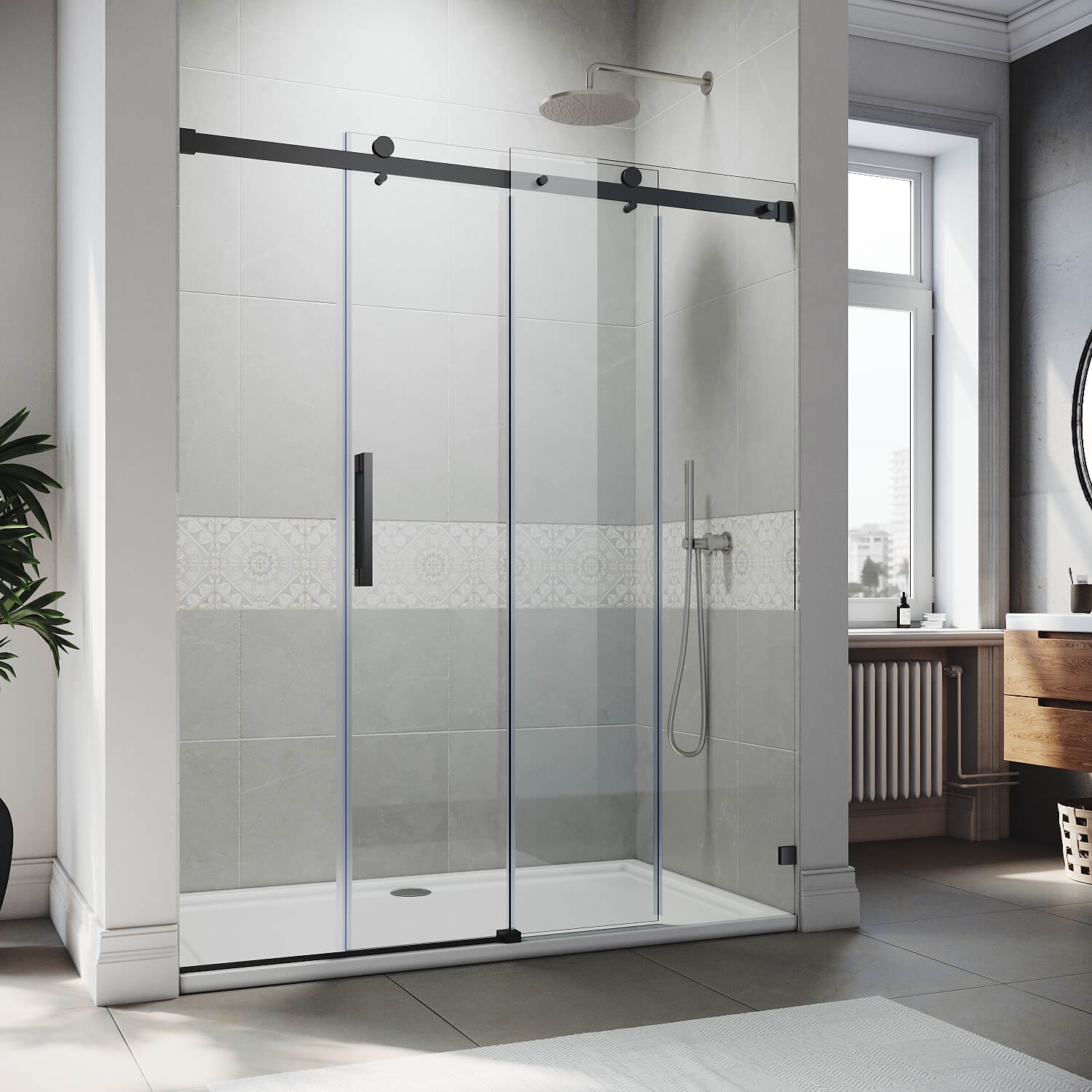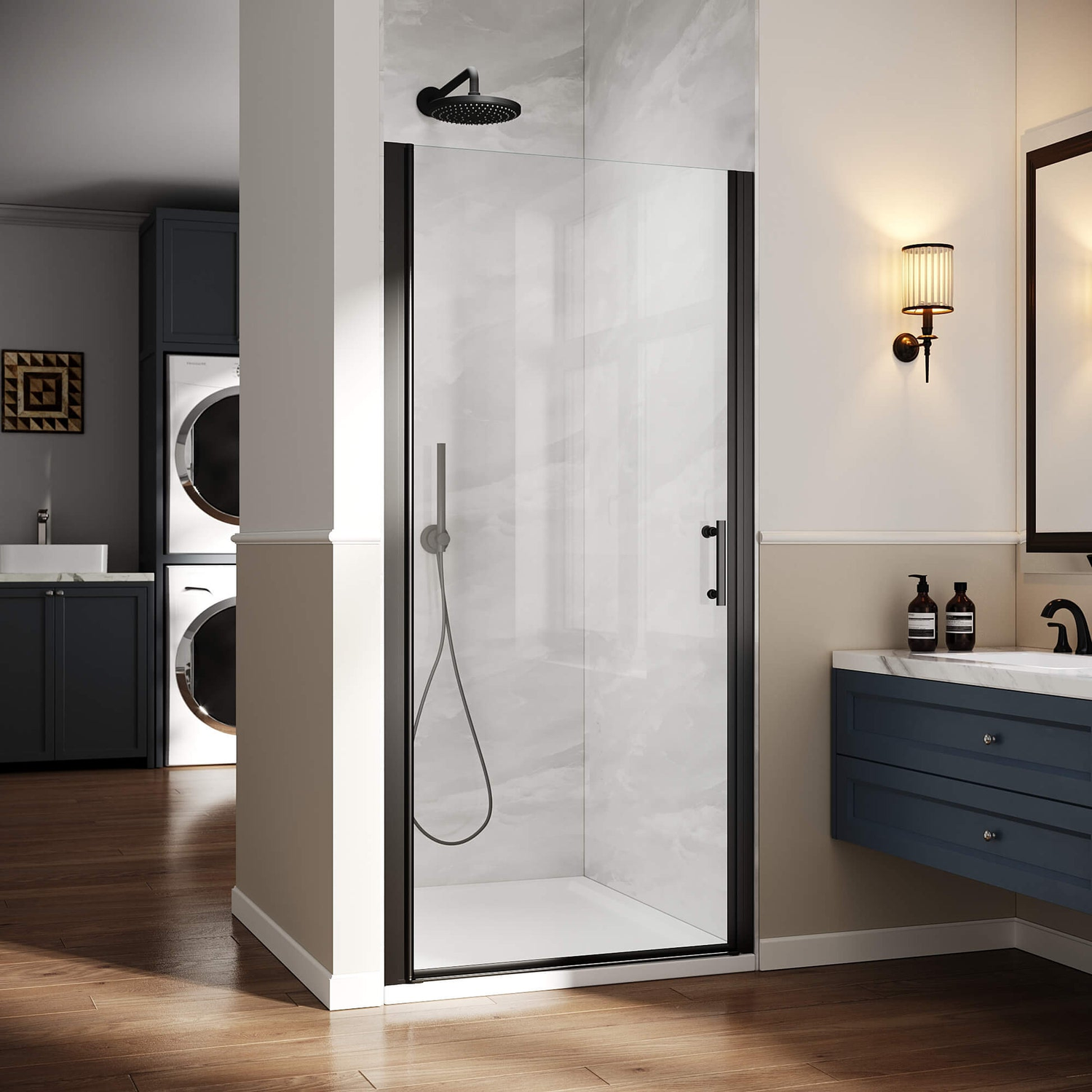The timeless elegance of a clawfoot tub or the sleek silhouette of a modern freestanding tub can be the centerpiece of any bathroom. These statement pieces evoke a sense of luxury and relaxation, hearkening back to a bygone era or defining a contemporary spa-like retreat. But for many homeowners, a crucial question arises, blending practicality with aesthetics: Can you install a shower door on a clawfoot tub? The desire for a quick, contained shower often clashes with the tub's standalone nature.
The short answer is yes, but it's not a simple, one-size-fits-all project. Transforming your beautiful soaking tub into a fully functional shower involves navigating unique challenges and making a fundamental choice between two distinct paths: the classic charm of a curved shower rod and curtain or the modern, sleek appeal of a custom glass enclosure.
This comprehensive guide will explore both shower door installation options for your freestanding tub, diving deep into the pros, cons, costs, and critical challenges. By the end, you'll have all the information needed to make the right decision for your home, budget, and style.
Understanding Your Tub: Clawfoot vs. Freestanding Tub Basics
Before we delve into shower door installation, it's essential to understand the canvas we're working with. While the terms are often used interchangeably, there's a subtle distinction.
A clawfoot tub is a specific type of freestanding bathtub characterized by its iconic elevated feet, often shaped like animal claws or ball-and-claw designs. These are typically vintage or vintage-style cast-iron tubs, prized for their classic aesthetic.
A freestanding tub is a broader category that includes clawfoot tubs but also encompasses modern designs like pedestal tubs (which rest on a solid base), soaking tubs with smooth, flat bottoms, and sculptural acrylic tubs. The common thread? They are not attached to any walls on their sides.
This very feature—the lack of adjacent walls—is the central challenge and the reason why adding a shower door for a freestanding tub is a specialized endeavor.
Shower Door Installation on a Clawfoot Tub: Is It Possible?
So, can you technically install a shower door on a clawfoot tub? Absolutely. However, this is not a standard, off-the-shelf project you'd find for a built-in tub-shower combo. The primary hurdle is creating a structurally sound and water-tight enclosure without the benefit of pre-existing walls on three sides.
This requires careful planning around two core needs:
-
Structural Support: A glass panel needs to be securely anchored, either to the floor, the ceiling, or a combination of both.
-
Water Containment: Without a built-in shower pan, the entire system must be designed to direct all water back into the tub and protect your bathroom floor from moisture damage.
The solutions to these challenges boil down to two main approaches, which we will explore in detail.
Option 1: The Curved Shower Rod and Curtain Solution
For most owners of vintage-style tubs, the curved shower rod for a clawfoot tub is the go-to solution. It's the traditional and most common way to add shower functionality.
Installing a Curved Shower Rod on Your Clawfoot Tub
This system involves a U-shaped or oval-shaped rod that arcs over the tub, providing a curtain track that maximizes interior space. Installing a clawfoot tub shower curtain is a relatively straightforward process that can often be handled as a DIY project.
Pros of a Clawfoot Tub Shower Curtain:
-
Cost-Effective: This is by far the most budget-friendly option. A quality curved rod and a liner/curtain set will cost a fraction of a custom glass enclosure.
-
Preserves Vintage Aesthetic: For a historic home or a strictly traditional bathroom, a curtain is period-appropriate and enhances the classic look of a clawfoot tub.
-
Easy Installation: Most systems are designed for DIY installation with basic tools, involving mounting brackets to the wall or, in some cases, the ceiling.
-
Safety and Softness: A fabric curtain is soft and pliable, eliminating the risk of hard impacts against glass, which is a consideration in smaller bathrooms.
Cons of a Clawfoot Tub Shower Curtain:
-
Water Containment Issues: Even the best curtains can allow water to splash onto the floor. The curtain can also cling to the user, exacerbating the problem.
-
Less Luxurious Feel: While beautiful, a curtain doesn't offer the same high-end, spa-like experience as a glass door.
-
Maintenance: Fabric curtains and plastic liners are prone to mildew and need regular cleaning and replacement.
Installation Considerations: You'll need to choose between a wall-mounted rod or a more dramatic ceiling-mounted rod. Precise measurement of your tub's length and width is crucial to ensure the rod fits perfectly and the curtain adequately surrounds the tub.
Option 2: The Custom Glass Shower Door Enclosure
For those seeking a contemporary, minimalist look and superior functionality, a custom glass shower door is the ultimate solution. This approach transforms your freestanding tub into a stunning, walk-in shower experience.
Installing a Glass Shower Door on a Freestanding Tub
This process involves a professional glass company fabricating tempered glass panels specifically for your tub and bathroom layout. The glass shower door installation is complex and should always be handled by experienced professionals.
Types of Glass Enclosures for Freestanding Tubs:
-
Single Panel Shower Screen: A single fixed panel of glass, typically placed at the head of the tub where the showerhead is. This is a minimal option that offers some splash protection but is not a full enclosure.
-
Partial Enclosure: Two glass panels that meet at a corner, often using the existing bathroom walls to form a three-sided shield. This offers better containment than a single panel.
-
Full Shower Door Enclosure: A multi-panel system that includes a door for entry. This is the most effective at containing water and creates a dedicated "shower room" around your tub.
Pros of a Custom Glass Shower Door:
-
Superior Water Containment: When properly installed, a glass enclosure effectively keeps all water inside the bathing area, protecting your floors and walls.
-
Modern, Open Aesthetic: Frameless glass creates a clean, open, and luxurious look. It showcases the tub as a piece of art while adding a modern touch.
-
Easy to Clean: Glass is non-porous and, when treated with a water repellent coating, is simple to wipe down and keep spotless.
-
Increases Home Value: The high-end appeal of a custom glass shower door for a freestanding tub is a significant selling point that can boost your home's resale value.
Cons of a Custom Glass Shower Door:
-
High Cost: Custom fabrication and professional installation make this the most expensive option by a wide margin.
-
Potential Style Clash: A large glass structure can visually compete with or overwhelm the vintage charm of a traditional clawfoot tub.
-
Complex Installation: This is not a DIY job. It requires precise measurements, potentially complex plumbing adjustments, and expert anchoring to ensure stability and safety.
Key Challenges of Installing a Shower Door on a Freestanding Tub
Choosing the glass shower door route means confronting several specific freestanding tub shower door installation challenges. Being aware of these hurdles is crucial for planning and budgeting.
-
Water Containment and Flooring Protection: The biggest issue is the lack of a shower pan. All water must be directed into the tub drain. This often requires ensuring the tub is perfectly level and that the flooring around it is waterproofed, sometimes necessitating a tiled curb or a specially designed drain channel in the floor.
-
Plumbing and Showerhead Placement: The plumbing for a freestanding tub shower is exposed. The riser pipe and showerhead must be strategically placed so that the water stream is effectively caught by the enclosure and doesn't spray out through gaps.
-
Structural Support and Stability: A large, heavy piece of glass must be immovably secure. Installers may need to anchor panels directly to the floor joists or ceiling, which can involve significant construction work. The type of floor (concrete vs. wood subfloor) also impacts the anchoring method.
-
Finding the Right Professional: Not every glass company has experience with freestanding tubs. You need to find a specialist who understands the unique structural and water-proofing requirements of this type of project.
Cost Analysis: Clawfoot Tub Shower Door vs. Curtain Rod
Let's break down the numbers. The cost difference between the two options is dramatic and is often the primary deciding factor for homeowners.
Clawfoot Tub Shower Door Cost vs. Curtain Cost
This option is renowned for its affordability and accessibility. For many homeowners, it provides the necessary functionality without breaking the bank.
Cost of a Curved Shower Rod and Curtain System:
-
Curved Shower Rod: $50 - $200
-
Curtain & Liner: $20 - $100
-
Total Estimated Cost (DIY Installation): $70 - $300
This is a highly accessible price point for most budgets, and the installation is straightforward enough to be a weekend DIY project.
Cost of a Custom Glass Shower Door Enclosure:
This cost is highly variable based on the glass type (thickness, clarity, texture), the complexity of the design, and your geographic location.
-
Materials (Tempered Glass, Hardware): $500 - $1,500+
-
Professional Installation: $500 - $1,500+
-
Total Estimated Cost: $1,000 - $3,000+
For a full, multi-panel enclosure with a door, it's not uncommon for costs to reach the higher end of this spectrum or even exceed it.
| Feature | Curtain & Rod | Custom Glass Enclosure |
|---|---|---|
| Cost | $70 - $300 | $1,000 - $3,000+ |
| Installation | DIY-Friendly | Professional Required |
| Water Containment | Fair | Excellent |
| Aesthetic | Classic, Vintage | Modern, Spa-like |
| Maintenance | Moderate (Cleaning/Replacement) | Easy (Wipe Down) |
Making the Decision: Which Shower Door Option is Right for Your Tub?
So, how do you choose? Your decision will ultimately hinge on your budget, your desired aesthetic, and your tolerance for potential water splash.
Choose a Curtain and Rod if:
-
You are working with a limited budget.
-
You want to preserve the authentic, classic look of your clawfoot tub.
-
You are comfortable with a DIY project.
-
Occasional water splash is not a major concern.
Choose a Custom Glass Shower Door if:
-
Budget is less of a primary constraint.
-
You desire a modern, luxurious, and spa-like bathroom experience.
-
Superior water containment is a non-negotiable priority.
-
You are prepared to hire and work with a qualified professional.
Conclusion: Transforming Your Tub into a Functional Shower
Adding shower functionality to your beautiful clawfoot or freestanding tub is not only possible but can be a transformative upgrade for your bathroom's practicality. The journey comes down to a fundamental choice between the timeless, cost-effective elegance of a curved rod and shower curtain and the sleek, high-performance luxury of a custom glass enclosure.
By carefully weighing the pros, cons, costs, and challenges outlined in this guide, you can move forward with confidence. Whether your priority is preserving a vintage charm or achieving a modern spa-like oasis, the right solution exists.
Ready to Take the Next Step?
If the stunning, splash-free appeal of a custom glass enclosure is the right choice for your home, navigating the specifics can be the final hurdle. For those seeking expert guidance and premium solutions, Sunny Shower is here to help.
Visit the Sunny Shower Doors today to explore our wide range of custom shower door solutions designed to complement any bathroom style. Our team of professional consultants is on standby to provide personalized advice, answer your specific questions about freestanding tub installations, and help you bring your vision to life with confidence.
Don't just dream about your perfect bathroom—make it a reality. Explore your options at Sunny Shower US now!








